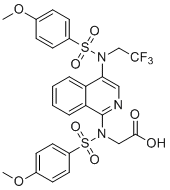| DC70709 |
PRL-295
|
PRL295 is a small molecule Keap1-Nrf2 protein–protein interaction inhibitor.PRL295 binds to Keap1 in the cellular environment, disrupting its interaction with Nrf2, which leads to enhanced gene expression of the classical Nrf2 target NQO1 in cells and in vivo in the mouse liver.PRL-295 increases the thermostability of Keap1 in cell lysates and in live cells.PRL 295 decreased the levels of plasma alanine aminotransferase and aspartate aminotransferase upon acetaminophen-induced hepatic injury. |
| DC70623 |
MSU38225
|
MSU 38225 (MSU-38225) is a novel small molecule that inhibit the Nrf2 pathway, potentially inhibiting Nrf2 transcriptional activity and cancer cell growth;
MSU38225 downregulates Nrf2 transcriptional activity and decreases the expression of Nrf2 downstream targets, including NQO1, GCLC, GCLM, AKR1C2, and UGT1A6.
MSU38225 strikingly decreases the protein level of Nrf2, which can be blocked by the proteasome inhibitor MG132.
Ubiquitination of Nrf2 is enhanced following treatment with MSU38225.
By inhibiting production of antioxidants, MSU38225 increases the level of reactive oxygen species (ROS) when cells are stimulated with tert-butyl hydroperoxide (tBHP).
MSU38225 also inhibits the growth of human lung cancer cells in both two-dimensional cell culture and soft agar. |
| DC40756 |
CBR-470-1
|
CBR-470-1 is an inhibitor of the glycolytic enzyme phosphoglycerate kinase 1 (PGK1). CBR-470-1 is also a non-covalent Nrf2 activator. CBR-470-1 protects SH-SY5Y neuronal cells against MPP+-induced cytotoxicity through activation of the Keap1-Nrf2 cascade. |
| DC8198 |
RTA-408(Omaveloxolone)
|
RTA-408 is a synthetic triterpenoid that potently activates the antioxidative transcription factor Nrf2 and inhibits the proinflammatory transcription factor NF-κB. |
| DC4135 |
Bardoxolone methyl
|
Bardoxolone methyl (also known as “RTA 402” and “CDDO-methyl ester”) is an orally-available first-in-class synthetic triterpenoid belonging to the antioxidant inflammation modulator (AIM) class. |






















